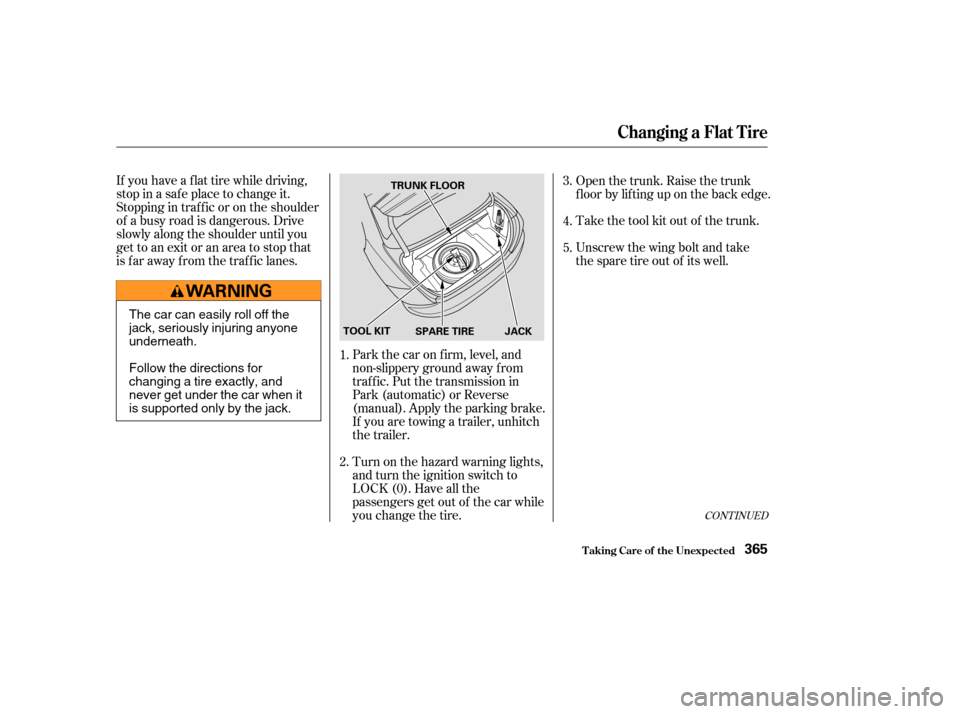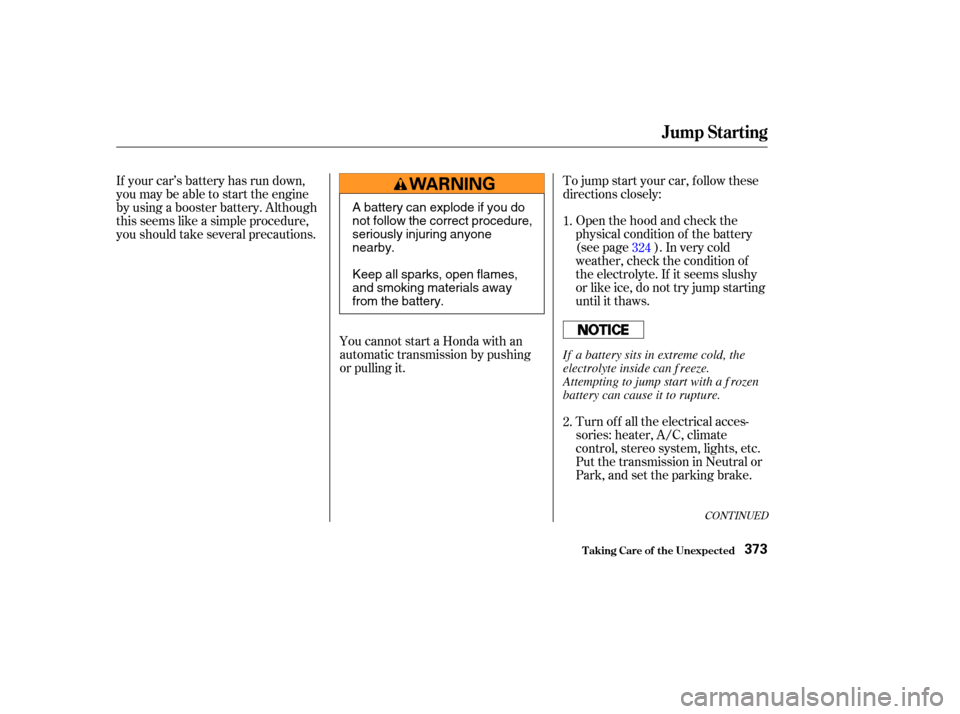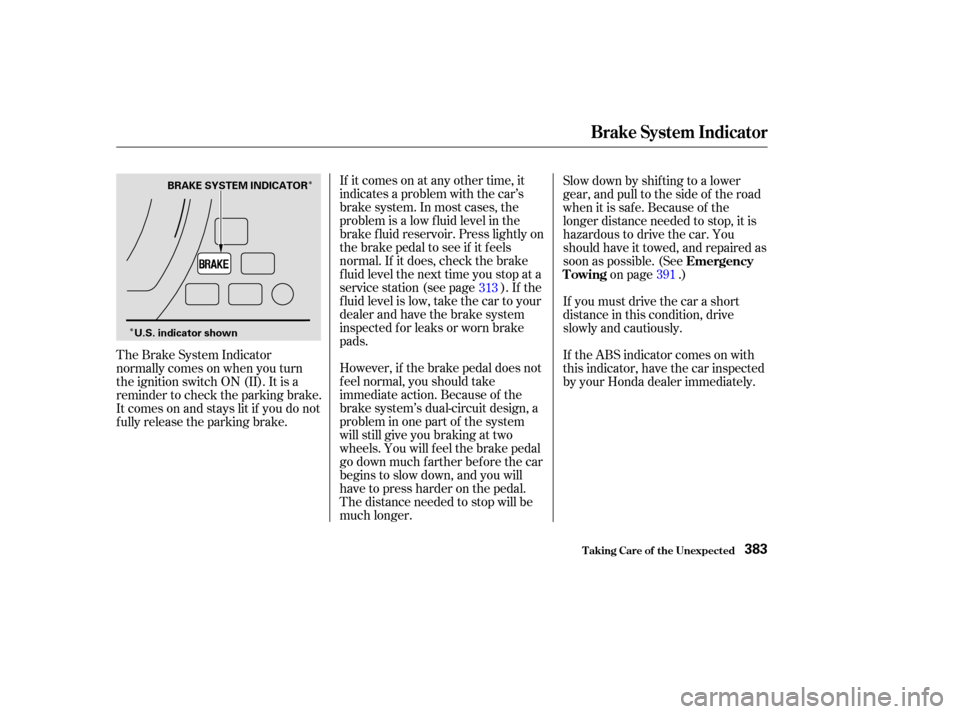Page 344 of 429
Check the f ollowing:Headlights (low and high beam)
Parking lights
Taillights
Brake lights
High-mount brake light
Turn signals
Back-up lights
Hazard light f unction
License plate lights
Side marker lights
Daytime running lights
(Canadian models)
If you f ind any bulbs are burned out,
replace them as soon as possible.
Refer to the chart on pages and to determine what type of
replacement bulb is needed. 397
399
Lights
Maint enance341
TURN SIGNAL LIGHT
BACK-UP LIGHT
STOP/TAILLIGHT/
SIDE MARKER LIGHT LICENSE PLATE LIGHTS
HIGH-MOUNT BRAKE LIGHT
Page 353 of 429
Open the trunk and remove the
socket f rom the light assembly by
turning it one-quarter turn counter-
clockwise.
Remove the burned-out bulb by
pulling it straight out of the socket.
Install the new bulb in the socket.Reinstall the socket. Turn it clock-
wise until it locks.
Turn on the lights to make sure
the new bulb is working.
1. 2. 3.
4.
Replacing a High-mount Brake
Light Bulb
Lights
Maint enance350
BULB
SOCKET
Page 357 of 429

Block the rear wheels.
Fill the f uel tank.
Wash and dry the exterior
completely.
Cleantheinterior.Makesurethe
carpeting, floor mats, etc. are
completely dry.
If you need to park your car f or an
extended period (more than one
month), there are several things you
should do to prepare it f or storage.
Proper preparation helps prevent
deterioration and makes it easier to
get your car back on the road. If
possible, store your car indoors.
If the car is to be stored for a
longer period, it should be
supported on jackstands so the
tires are of f the ground.
Leave one window open slightly (if
the car is being stored indoors).
Disconnect the battery.
Support the f ront wiper blade
arms with a f olded towel or rag so
they do not touch the windshield.Coverthecarwitha‘‘breathable’’
cover, one made f rom a porous
material such as cotton.
Nonporous materials, such as
plastic sheeting, trap moisture,
which can damage the paint.
If possible, run the engine f or a
while periodically (pref erably once
amonth).
To minimize sticking, apply a
silicone spray lubricant to all door
and trunk seals. Also, apply a car
body wax to the painted surf aces
that mate with the door and trunk
seals.
Change the engine oil and f ilter
(see page ).
If you store your car f or 12 months
or longer, have your Honda dealer
perf orm the inspections called f or in
the 24 months maintenance schedule
(Normal Conditions) as soon as you
take it out of storage (see page ).
The replacements called f or in the
maintenance schedule are not
needed unless the car has actually
reached that time or mileage.
Leave the parking brake off. Put
the transmission in Reverse
(manual) or Park (automatic). 296
274
Maint enance
St oring Your Car
354
Page 368 of 429

If you have a f lat tire while driving,
stop in a saf e place to change it.
Stopping in traf f ic or on the shoulder
of a busy road is dangerous. Drive
slowly along the shoulder until you
gettoanexitoranareatostopthat
is far away from the traffic lanes.Open the trunk. Raise the trunk
f loor by lif ting up on the back edge.
Take the tool kit out of the trunk.
Unscrew the wing bolt and take
the spare tire out of its well.
If you are towing a trailer, unhitch
the trailer. Park the car on f irm, level, and
non-slippery ground away f rom
traffic. Put the transmission in
Park (automatic) or Reverse
(manual). Apply the parking brake.
Turn on the hazard warning lights,
and turn the ignition switch to
LOCK (0). Have all the
passengers get out of the car while
you change the tire. 5.
4.
3.
2. 1.
CONT INUED
Changing a Flat T ire
T aking Care of t he Unexpect ed365
TRUNK FLOOR
SPARE TIRE JACK
TOOL KIT
The car can easily roll off the
jack, seriously injuring anyone
underneath.
Follow the directions for
changing a tire exactly, and
never get under the car when it
is supported only by the jack.
Page 376 of 429

Put the transmission in Neutral or
Park, and set the parking brake. Open the hood and check the
physical condition of the battery
(see page ). In very cold
weather, check the condition of
the electrolyte. If it seems slushy
or like ice, do not try jump starting
until it thaws.
To jump start your car, f ollow these
directions closely:
If your car’s battery has run down,
you may be able to start the engine
by using a booster battery. Although
this seems like a simple procedure,
you should take several precautions.
You cannot start a Honda with an
automatic transmission by pushing
or pulling it. Turn of f all the electrical acces-
sories: heater, A/C, climate
control, stereo system, lights, etc.
1.
2.
324
CONT INUED
Jump Starting
T aking Care of t he Unexpect ed373
A battery can explode if you do
not follow the correct procedure,
seriously injuring anyone
nearby.
Keep all sparks, open flames,
and smoking materials away
from the battery.
If a battery sits in extreme cold, the
electrolyte inside can f reeze.
Attempting to jump start with a f rozen
battery can cause it to rupture.
Page 386 of 429

�Î
�ÎIf it comes on at any other time, it
indicates a problem with the car’s
brake system. In most cases, the
problem is a low f luid level in the
brake f luid reservoir. Press lightly on
the brake pedal to see if it f eels
normal. If it does, check the brake
f luid level the next time you stop at a
service station (see page ). If the
fluid level is low, take the car to your
dealer and have the brake system
inspected f or leaks or worn brake
pads.
However, if the brake pedal does not
f eel normal, you should take
immediate action. Because of the
brake system’s dual-circuit design, a
problem in one part of the system
will still give you braking at two
wheels. You will f eel the brake pedal
go down much f arther bef ore the car
begins to slow down, and you will
have to press harder on the pedal.
The distance needed to stop will be
much longer. Slow down by shif ting to a lower
gear, and pull to the side of the road
when it is saf e. Because of the
longer distance needed to stop, it is
hazardous to drive the car. You
should have it towed, and repaired as
soon as possible. (See
on page .)
The Brake System Indicator
normallycomesonwhenyouturn
the ignition switch ON (II). It is a
reminder to check the parking brake.
It comes on and stays lit if you do not
f ully release the parking brake. If you must drive the car a short
distance in this condition, drive
slowly and cautiously.
If the ABS indicator comes on with
this indicator, have the car inspected
by your Honda dealer immediately.
313
391Emergency
Towing
Brake System Indicator
T aking Care of t he Unexpect ed383
BRAKE SYSTEM INDICATOR
U.S. indicator shown
Page 400 of 429

�µ
�µ
�µ
�µ
�µ
�µ
�µ
�µ
�µ
�µ
�µ
�µ
�µ
�µ
�µ
�µ
�Î
�Î
�Î
�Î�Î
�Î
�Î
�Î
T echnical Inf ormation
Specif ications ( 4-cylinder Models)
397
Battery
Fuses Lights Engine
Alignment
Tires
12 V
12 V
24/2.2 CP
12 V
12 V
60 W (HB3)
51 W (HB4)
12 V
12 V
12 V
12 V
12 V
12 V 12 V
12 V
12 V 21 W
21/5 W
18 W
3CP
8W
21 W
5W
2CP
1.1 W
8W
Capacity 12 V
12 V 38 AH/5 HR
47 AH/20 HR
Interior
Under-hood Headlights
Front turn signal/parking/side
marker lights
Rear turn signal lights
Back-up lights
License plate lights
Ceiling light
High-mount brake light
Trunk light
Door courtesy lights
Vanity mirror lights
Spotlights
See page390or the fuse label
attached to the inside of the fuse
box lid.
See page 389or the fuse box
cover. Water cooled 4-stroke i-VTEC
4-cylinder gasoline engine
Type
BorexStroke
Displacement
Compression ratio
Spark plugs 3.43 x 3.90 in (87.0 x 99.0 mm)
144 cu-in (2,354 cm
)
9.7 : 1
See spark plug maintenance sec-
tion page 320 .
Toe-in
Camber
Caster 0.00 in (0.0 mm)
0.08 in (2.0 mm)
0°1°
3°15’
Size
Pressure P205/65R15 92H
P205/60R16 91V
T135/90D15 100M
30 psi (210 kPa , 2.1 kgf/cm
)
32 psi (220 kPa , 2.2 kgf/cm)
29 psi (200 kPa , 2.0 kgf/cm)
30 psi (210 kPa , 2.1 kgf/cm)
60 psi (420 kPa , 4.2 kgf/cm)
Front
Rear
Front
Rear
Front
High
Low
1: LX
2: EXFront/Rear
Spare
Front
Rear
Spare
Stop/taillight/side marker lights
1
2
1
2
1
2
Page 402 of 429

�µ
�Î
�Î
�µ
�µ
�µ
�µ
�µ
�µ
�µ
�µ
�µ
�µ
�µ
�µ
�µ
�µ
�µ
�Î
�Î
�Î
�Î
�Î
�Î
T echnical Inf ormation
Specif ications ( 6-cylinder Models)
399
Engine
Alignment
Lights
Battery
Fuses
Tires Type
BorexStroke
Displacement
Compression ratio
Spark plugs
Toe-in
Camber
CasterWater cooled 4-stroke
SOHC VTEC
6-cylinder gasoline engine
Headlights
Front turn signal/parking/side
marker lights
Rear turn signal lights
Back-up lights
License plate lights
Ceiling light
High-mount brake light
Trunk light
Door courtesy lights
Vanity mirror lights
Spotlights
Capacity
Interior
Under-hood Size
Pressure
12 V
12 V
12 V
12 V
12 V
12 V
12 V
12 V
12 V
12 V
12 V
12 V
12 V
12 V
12 V
63 W (HB3)
51 W (HB4)
24/2.2 CP
21 W
21/5 W
18 W
3CP
8W
21 W
5W
2CP
1.1 W
8W
52 AH/5 HR
65 AH/20 HR
3.39 x 3.39 in (86.0 x 86.0 mm)
183 cu-in (2,997 cm
)
10.0 : 1
0.00 in (0.0 mm)
0.08 in (2.0 mm) 0°1°
3°15’
P215/50R17 93V P205/60R16 91V
T135/90D15 100M
32 psi (220 kPa , 2.2 kgf/cm
)
T135/80R16 101M
See page 390or the fuse label
attached to the inside of the fuse
box lid.
See page 389or the fuse box
cover. 60 psi (420 kPa , 4.2 kgf/cm
)
29 psi (200 kPa , 2.0 kgf/cm)
30 psi (210 kPa , 2.1 kgf/cm)
See spark plug maintenance sec-
tion page 323 .
Front
Rear
Front
Rear
Front
High
Low
1:
2:LX-V6, EX-V6 with automatic transmission
EX-V6 with manual transmission Front/Rear
Spare
Front
Rear
Spare
Stop/taillight/side marker lights
1
2
1
2
1
2